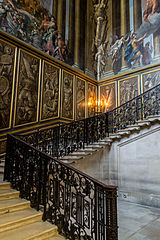Jean Tijou


Jean Tijou (fl. 1689–1712) was a French
Little else is known of Jean Tijou or his training other than that he was a master metalworker.
Works
His major commissions include gates and railings for Hampton Court Palace, where he worked between 1689 and 1700;[5] he was paid £2,160 2s 0.25d for the wrought iron screens at the river end of the "Privy Garden" at Hampton Court.[6] He also is known to have worked at Kensington Palace. He produced the screens and grilles of St Paul's Cathedral for Sir Christopher Wren. Tijou's work shown at St. Paul's Cathedral is different from his usual work because it does not contain the repoussé trademark he is known for. Instead it focuses on scrollwork and harmony to the building rather than setting the gate as emphasis no matter the architecture attached to it. [7] He also worked at country houses such as Easton Neston, Burghley and Chatsworth. At Chatsworth his surviving works include the balustrade of the upper flight of the grand staircase and the set of gates known as the Golden Gates, which were moved to their present location at the north entrance to the park in the 19th century.[citation needed]
Tijou elevated
It is possible that a portrait of Jean Tijou appears at the bottom of the title page of a book entitled A New Book of Drawings Invented and Designed [sic] by John Tijou,
Influence on Ironwork
After Jean Tijou left England in 1712, his work continued to be influential to other artists. Starting in the 18th century cast iron became more popular for its use within wrought iron assemblies. It was also used alone for structures such as railings that required less ornament and detail. The Iron work of Tijou even influences the entrance gates that are seen at Chirk Castle located near Llangollen (1719). While the original cast iron gates at St. Paul's Cathedral were not approved (removed in 1714), they provided one of the earliest examples of decorative cast iron work. These gates inspired the creativity of decoration on cast iron to be explored during the golden age. Jean Tijou's use of cast iron shows his in depth understanding for the use of materials. [13]
Gallery
-
Golden Gates, Kensington Palace, late 17th century, attributed to Tijou
-
View from the outside of screens at Hampton Court Palace, c. 1700
-
Hampton Court Palace, screen representing Scotland, c. 1700
-
Hampton Court Palace, screen representing Ireland, c. 1700
-
Hampton Court Palace, screen
-
Gates in St Paul's Cathedral, London
-
Burghley House, entrance, with Tijou's Golden Gates at the base
-
Burghley House, with Tijou's Golden Gates in background
-
Balustrade of King's Staircase, Hampton Court Palace, c. 1695
References
- ^ a b Lister 1957, p. 92.
- ^ Lucas, Justin (April 2019). "Challenging the Aesthetics and Functionality of Metals in Contemporary Blacksmithing" (PDF). Retrieved November 11, 2022.
- ^ a b Lister 1957, p. 93.
- ISBN 978-1-4733-4018-3.
- ^ Harris 1960, p. 4.
- ^ Lister 1957, p. 94.
- OCLC 960041197.
- ^ "Engraving of Tijou, Jean on V&A Search the Collections)".
- OCLC 960041197.
- ^ Cooper Hewitt, Smithsonian Design Museum. "Album, New Book of Drawings". Smithsonian Institution. Retrieved 7 April 2022.
- ^ V&A Museum
- OCLC 960041197.
- OCLC 960041197.
Bibliography
- Harris, John (1960). English Decorative Ironwork from Contemporary Source Books 1610–1836. London: Alec Tiranti Ltd. OCLC 30213283.
- Lister, Raymond (1957). Decorative Wrought Ironwork in Great Britain. London: Alec Tiranti Ltd. OCLC 1046341139.
External links
- An illustrated page about Tijou's work at St Paul's Cathedral
- Cooper Hewitt, Smithsonian Design Museum. "Album, New Book of Drawings". Smithsonian Institution. Retrieved 15 May 2017.









